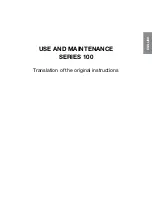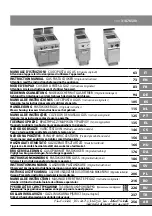
9
ENGLISH
NOTE:
Mixer must rest at least 1 hour
after extruding 2 consecutive pasta
dough recipes.
Dough
• Learning to make homemade pasta
is simply a matter of practice. If you
have not made pasta, you may have to
prepare several batches of dough before
you feel comfortable. We recommend
experimenting with the Basic Egg
Noodle Pasta Recipe.
• The ratio of liquid to flour is small,
making the pasta dough firm and
leathery, but still pliable. It is extremely
important to have the correct proportion
of ingredients for proper dough
consistency, as dough that is too moist
or too dry will be difficult to work
with. To help you achieve consistent
results, the pasta recipes in this booklet
specify sifted flour. To sift flour, follow
this procedure: Place dry ingredient
measuring cup on a large piece of waxed
paper and hold sifter directly above and
close to cup. Scoop flour into sifter and
sift until flour exceeds top of cup. Using
the flat edge of a spatula, remove excess
flour from measuring cup.
• Occasionally, there may be unmixed
pieces of dough in the bowl after initial
mixing with the flat beater. These pieces
will be sufficiently incorporated by
stand mixer kneading followed by hand
kneading which firms and smoothes the
texture of the dough.
• Many factors, such as humidity, brand
of flour used, and size of eggs, can
affect dough consistency. To compensate
for humid conditions, start the initial
mixing process with only the sifted
flour and eggs. Check the dough for
proper consistency by pinching a small
amount of dough together after mixing
with the flat beater. The dough should
stay together without sticking to your
fingers. It may be necessary to add a
small amount of water or flour to reach
correct dough consistency.
• If the prepared dough is too moist or
sticky to extrude, simply dust with flour
or pat some flour into the dough before
placing in the extruder.
Using Your Pasta Press and
KitchenAid
®
Stand Mixer
• Long noodles and macaroni tend to curl
in different directions as they extrude
through the plate. The first 10"
(25.0 cm) of curled noodles may be
pulled off and returned to the hopper
to be extruded again. Pasta will extrude
slowly at first, then faster as more
dough is extruded.
• Separate pasta immediately after extrusion.
Lay a group of noodles on a towel placed
on a flat surface and pull apart from drier
ends of strands. Dry in a single layer. Long
strands of pasta may be placed on a
KitchenAid
®
Drying Rack (KPDR).
• Homemade pasta behaves differently
than store-purchased pasta. Because
long noodles bend as they dry and
are more fragile, they require gentle
handling before cooking.
Storing Your Pasta
• Store dried pasta in an airtight glass or
plastic container almost indefinitely in a
cool, dark place. However, do not store
dried whole-wheat pasta for more than
1 month, as it may turn rancid.
• To store fresh pasta, air dry for 1 hour,
then wrap in an airtight plastic bag and
refrigerate for up to 5 days. To freeze,
double wrap the pasta and keep frozen
for up to 4 months. To use frozen
fresh pasta, do not thaw – it should go
directly from freezer into boiling water.
Pasta Making Tips
WARNING
Food Poisoning Hazard
Do not let foods that contain
perishable ingredients such as
eggs, dairy products, and
meats remain unrefrigerated for
more than one hour.
Doing so can result in food
poisoning or sickness.
Содержание KPEXTA
Страница 71: ......












































